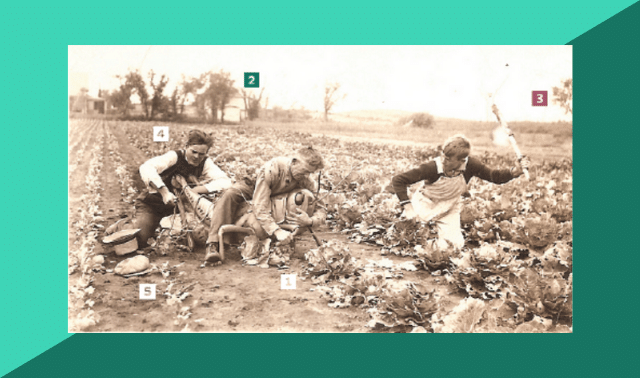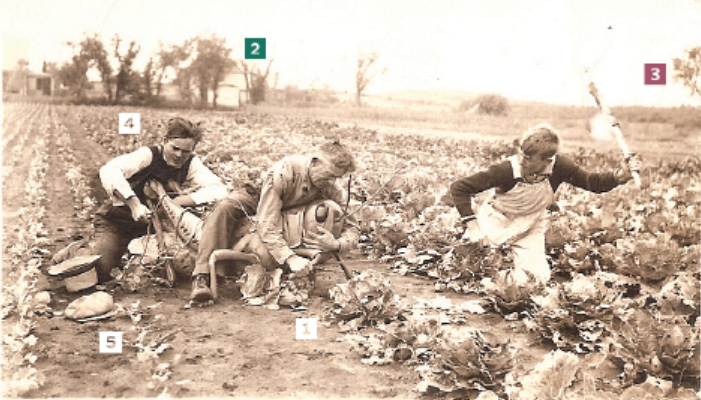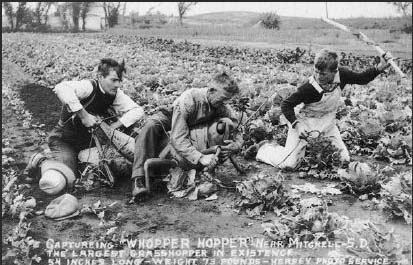Sign up for the Family Tree Newsletter Plus, you’ll receive our 10 Essential Genealogy Research Forms PDF as a special thank you!
Get Your Free Genealogy Forms
"*" indicates required fields
Larae Schraeder showed me this picture featuring a giant grasshopper sculpture at the 2012 National Genealogical Society Conference in Cincinnati. The photo was in her collection of family pictures, and she thought the men might be relatives.
Well, it turns out the men aren’t relatives. The real story is a fascinating historical tale of one man’s hobby.
The Background
Larae Schraeder owns this snapshot, part of a collection she inherited from her great-grandparents Ralph M. and Nettie (Finley) Jeffers. Knowing the provenance of a photo can help you narrow down who’s in it. Schraeder also shared dates, documents and photos with me to aid the identification.
She believes these men might be related to Eliza (Jeffers) Coon, also spelled Kuhn, born in 1847 in Gallia County, Ohio. Eliza died in 1929 in Vernon, Mo. A branch of the Jeffers family had settled in Kansas by 1880. Schraeder knows that members of the Ohio Jefferses stayed in touch with the Missouri branch until the second decade of the 20th century.
Eliza’s brother Charles Phillip Jeffers also moved west from Ohio and died in January 1919 in Marion County, Kan. According to the 1880 census, he was a farm laborer on his future father-in-law’s property. Charles married Rebecca Jane Riggs and they had two sons: Guy, born in 1889, and Ulysses Grant, born in 1883.
The man in the center has a long face, just like an 1880s image of Charles Jeffers that Schraeder shared with me. The young man to the left, who has similar features, could be his son Guy. But other clues suggest this photo was taken after World War I, when Guy and Ulysses would’ve been too old to be the young men in this image.
The men’s identities are a persistent mystery. Whoever they are, they enjoyed playacting for the camera. This is photographic folklore relatives must have chuckled about, but neglected to pass down to the next generation.
Photo Clues
Here’s what we can learn by looking at the details in this photo:
1. The largest swarms of grasshoppers plagued the American West and Midwest from 1874 to 1876, but there were also onslaughts in 1931, 1934, 1936 and 1939. Kansas became known as the Grasshopper State after the Great Swarm of 1874. The origin of this oversize metal insect is unknown, but it may have been meant to scare off the real ones.
2. This large farm grew cabbages. Heads to the left have been cut off at the ground, while the specimens to the right remain mostly intact. Both the size of the farm and the house in the background may help Schraeder discover who near her ancestors’ homes grew cabbages as a crop.
3. Schraeder can use family information, land records and topographical maps to determine the location of this farm. Where is the land mostly flat with a slight rise in the distance? The Jeffers family was large with siblings in Ohio, Missouri, Kansas, Washington and Kentucky. Researching each location, finding land documents and studying the terrain could help narrow the possibilities.
4. The men’s apparel suggests cool weather (though the crops show we’re still within the growing season). This young man wears a sleeveless sweater. A search of historical newspapers on subscription website GenealogyBank or sleeveless sweater confirms this was a fashion innovation popular after World War I. The sweaters were available for around $3.50 from department stores and the Sears catalog, or knitted by crafty wives and mothers.
5. The style of these hats was also common after World War I.
Mystery: Solved!
Thomas Talcott Hersey of Mitchell, SD, made this grasshopper. He’s the one holding it down in the photo. Assisting him are his nephew Harry (Bart) Hersey and David John Hersey.
Several Hersey descendants emailed me this weekend to tell me about this hopper and the other large bug sculptures Hersey crafted. His inspiration came from the grasshopper swarms that killed his crops during the Dust Bowl era, and he called the metal creation Galloping Gertie.
When he displayed his invention at Corn Palace Week in Mitchell and charged a nickel to view it, he earned enough to support his family for a winter. Hersey ended up with a commission from a man who hired him to make a housefly, a flea, a black widow spider, and a monarch butterfly to show at county fairs.
Hersey’s hobby of fashioning giant bugs out of wood, paper, cellophane, wire, string and oil cloth made him famous. In 1943, Hersey was a guest on Dave Elman’s “Hobby Lobby” radio show on CBS. He spoke at length about how he made the insects; the grasshopper shown here even had a device to make its feelers move. Life Magazine and Popular Mechanics featured articles on his work.
Hersey’s relatives sent me several other pictures of his bugs and his relatives posing with them. They emailed me a postcard view of the scene above that had a printed caption: “Capturing Whopper Hopper near Mitchell, S.D. The largest grasshopper in existence 54 inches weighs 73 pounds.” It was taken and marketed by the Hersey Photo Service:
Mystery solved!
Not all of the photos in a family collection depict relatives. Family members may have collected pictures of friends, neighbors and famous folks. In this case, we don’t know if Larae’s family actually saw Gertie or if they just bought the image for fun.
ADVERTISEMENT







